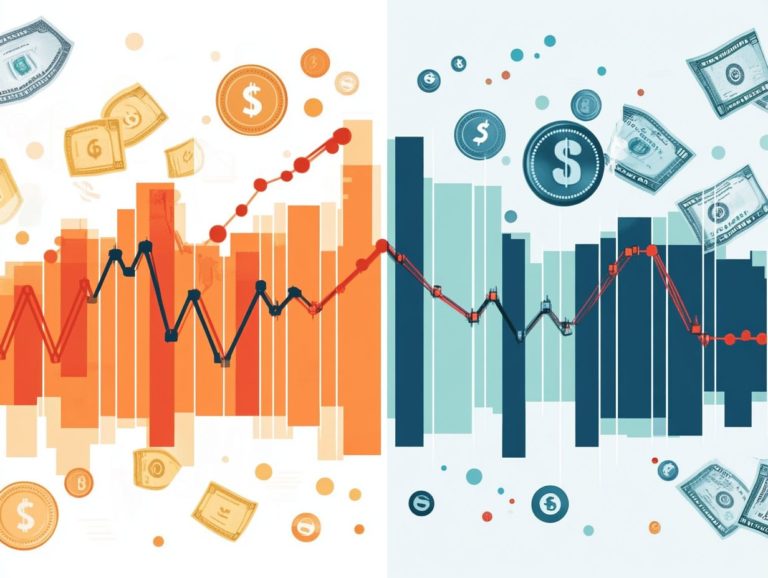The Impact of Interest Rates on Investment Risks
Interest rates wield significant influence in finance, impacting everything from savings accounts to investment strategies.
Understanding their definition and function empowers you to handle risks better. This article explores how interest rates affect your investment decisions, the associated risks, and effective strategies for managing those risks.
Consider your investment goals and economic factors to make smarter choices that resonate with your financial aspirations.
Dive into the details today to boost your investment savvy!
Contents
- Key Takeaways:
- Understanding Interest Rates
- How Interest Rates Affect Investments
- Risks Associated with Fluctuating Interest Rates
- Strategies for Managing Interest Rate Risks
- Diversification
- Hedging
- Factors to Consider When Evaluating Interest Rate Risks
- Frequently Asked Questions
- What is the relationship between interest rates and investment risks?
- How do rising interest rates impact different types of investments?
- What are the potential risks of investing during a period of low interest rates?
- How can investors mitigate the impact of interest rates on their investment risks?
- Are there any potential benefits to investing during a period of high interest rates?
- How does the Federal Reserve’s interest rate decisions impact investment risks?
Key Takeaways:

Interest rates play a crucial role in investments, influencing the level of risk in various options. Fluctuating interest rates can present different types of risks, including inflation, market, and interest rate risks, impacting investment returns. To manage these risks effectively, investors should consider diversification and hedging strategies, while also taking into account economic conditions and their investment goals and time horizon.
Understanding Interest Rates
Understanding interest rates is essential for grasping their impact on the economy, consumer behavior, and your investment strategies.
Interest rates influence a wide array of factors, including consumer spending and business investments. They serve as a mechanism through which the central bank manages the economy.
By adjusting the federal funds rate, the central bank can stimulate or temper economic activity, influencing everything from spending habits to corporate profits.
Interest rates do more than determine loan costs; they significantly affect market conditions across various sectors.
Definition and Function
Interest rates are the cost of borrowing money, expressed as a percentage of the total loan amount over a specific period. These rates affect consumer spending and business investments.
By determining the price of money, interest rates directly influence bond prices. When rates rise, existing bonds typically lose value, making new bonds more appealing. This dynamic affects borrowing costs; higher rates can mean increased expenses for mortgages or loans, ultimately slowing down economic growth.
On the other hand, lower interest rates can encourage borrowing and spending, creating a vibrant economic environment where businesses thrive and jobs are created.
How Interest Rates Affect Investments
Interest rates are fundamental in shaping your investment strategies, guiding both investors and businesses in the stock and bond markets.
When interest rates rise, borrowing costs increase, making it more expensive for corporations to fund expansion. This can dampen corporate profits, impacting stock prices.
Conversely, lower interest rates generally encourage consumer spending and stimulate investments, paving the way for economic growth.
Understanding the relationship between interest rates and investments is key to navigating market conditions effectively.
Relationship between Interest Rates and Investment Risks
The relationship between interest rates and investment risks is intertwined, with fluctuations impacting both the stock market and bond prices.
When interest rates rise, borrowing costs escalate, potentially leading to declines in corporate profits, which can reduce stock values. Conversely, when rates fall, bonds may lose their appeal, pushing investors to seek higher returns in stocks. This creates a competitive investment landscape.
Such dynamics introduce varying risk levels; for example, high-growth stocks may become more volatile with unexpected shifts in interest rates, while those in fixed-income securities might see their bond values diminish as rates rise.
Understanding these implications is crucial for anyone eager to navigate the modern investing landscape.
In light of these insights, consider reevaluating your investment strategies in relation to current interest rates.
Risks Associated with Fluctuating Interest Rates

Fluctuating interest rates can pose significant risks, impacting both investors and businesses.
These risks include inflation risk, market risk, and interest rate risk, each affecting economic stability in distinct ways.
For instance, rising interest rates can signal increased consumer costs and lower bond prices.
Understanding these risks helps you make informed financial decisions and develop effective investment strategies.
Inflation Risk
Inflation risk is closely tied to interest rates. When rates rise, they aim to control inflation but can also increase costs.
This balancing act impacts everything from your investment choices to your purchasing power.
When interest rates spike, you may face higher loan costs driven by metrics like the Consumer Price Index, which measures the average change over time in the prices paid by consumers for goods and services.
Higher expenses can reduce consumer spending, stifling economic growth.
Financial institutions monitor inflation signs, adjusting lending rates accordingly. Policymakers also use this data to shape fiscal strategies.
Understanding these dynamics empowers you to make savvy financial choices.
Market Risk
Market risk involves potential losses due to unfavorable price movements in stock or bond markets. This risk is linked to interest rate fluctuations, affecting borrowing costs and consumer spending.
Rising interest rates can increase financing costs, pushing businesses to cut back on spending.
As an investor, you face tough decisions as you navigate these market shifts.
Grasping the connection between interest rates and market risk is crucial for informed investment decisions.
Interest Rate Risk
Interest rate risk refers to losses from unexpected interest rate changes, impacting bond prices and borrowing costs.
This risk is vital for anyone dealing in the bond market. Fluctuations can significantly impact fixed-income securities.
When interest rates rise, existing bonds often lose market value, posing challenges for portfolio managers.
Conversely, falling rates can boost bond prices, making timing essential in your investment strategy.
By understanding monetary policy shifts, you can navigate interest rate risk more effectively.
Strategies for Managing Interest Rate Risks
To manage interest rate risks, adopt strategies like diversification and hedging.
These techniques help mitigate potential losses in fluctuating markets, allowing you to navigate the financial landscape with confidence.
Diversification

Diversification is a cornerstone strategy to mitigate interest rate risks. It enables you to spread your investments across various asset classes.
By allocating your funds into stocks, bonds, real estate, and commodities, you can craft a balanced portfolio that s less vulnerable to fluctuations from changes in interest rates.
This approach helps soften the blow of rising rates where bond prices typically take a hit. It also allows you to seize the growth potential offered by equities.
Diversifying internationally adds another layer of protection. Different economies respond distinctly to global monetary policies.
A well-diversified investment strategy is your secret weapon for navigating unpredictable markets!
Hedging
Hedging is a proactive strategy you can employ to offset potential losses from interest rate risks. It utilizes various financial instruments.
This approach often involves financial contracts whose value depends on an underlying asset, like options, futures, and swaps. It enables you to secure more favorable borrowing terms while protecting your portfolio from unexpected rate fluctuations.
Implementing these hedging techniques helps insulate you against the adverse impacts of rising interest rates, which could lead to increased financing costs.
Such risk management practices allow for better forecasting and strategizing in your investment decisions. They ensure that your portfolio remains resilient and aligned with your long-term financial goals.
As these strategies evolve, staying informed about market trends is essential for effective hedging.
Factors to Consider When Evaluating Interest Rate Risks
When assessing interest rate risks, several key factors influence your evaluation. Economic conditions, investment goals, and time horizons play crucial roles in shaping your financial decisions.
Each element intertwines, guiding you toward a more informed and strategic approach.
Economic Conditions
Economic conditions greatly influence interest rates, affecting how markets respond and how you approach your investment strategies.
As economic indicators like inflation, unemployment, and GDP growth shift, central banks adjust interest rates to align with these developments.
For instance, when inflation rises, higher interest rates may be implemented to temper excessive spending. This creates a ripple effect throughout financial markets.
As an investor, you might find yourself recalibrating your strategies. Some may turn their attention toward bonds to take advantage of attractive yields, while others delve into equities that flourish in a lower interest environment.
Understanding this dynamic interplay is crucial for making informed decisions that resonate with the constantly evolving economic landscape.
Investment Goals and Time Horizon
Investment goals and time horizons are critical factors when assessing interest rate risks. They profoundly influence your financial decision-making and spending behavior.
When establishing clear investment objectives be it for retirement, education, or significant purchases you need to consider the duration you plan to invest before accessing your funds.
A longer time horizon often permits a more aggressive investment strategy, helping buffer against potential interest rate volatility.
Conversely, if your timeline is shorter, you may need to adopt a more conservative approach, focusing on capital preservation rather than chasing higher returns.
Grasping these dynamics assists you in selecting the right asset classes that align with your goals, guiding your decisions as you navigate the intricate landscape of interest rate movements.
Frequently Asked Questions

1. What are interest rate risks?
2. How do I hedge against interest rate risks?
3. What factors should I consider when investing during rising interest rates?
What is the relationship between interest rates and investment risks?
Interest rates and investment risks are closely connected. Changes in interest rates can significantly affect the level of risk associated with investment opportunities.
As interest rates rise, the cost of borrowing money increases. This makes it more expensive for businesses to take out loans or issue bonds, leading to a decrease in investment activity and an increase in the perceived risk of potential investments.
How do rising interest rates impact different types of investments?
Rising interest rates can have varying effects on different types of investments. Generally, stocks and bonds tend to be negatively affected, becoming less desirable compared to other investments with higher interest rates.
On the other hand, investments such as real estate and commodities can thrive when interest rates rise, as they are considered more stable alternatives.
What are the potential risks of investing during a period of low interest rates?
Investing during a period of low interest rates may carry additional risks. Low interest rates can lead to an increase in asset prices and a decrease in potential returns.
This can create a risky bubble that may burst unexpectedly, making investments more vulnerable to market fluctuations and potential losses. Low interest rates may also indicate a weaker economy, posing its own set of risks to investments.
How can investors mitigate the impact of interest rates on their investment risks?
Wondering how to protect your investments from interest rate changes? Here s how! Investors can mitigate the impact by diversifying their portfolio.
This means spreading out investments across different asset classes, such as stocks, bonds, and real estate. By diversifying, you can minimize the impact of rising interest rates on any one investment.
It s also crucial to regularly review and adjust your portfolio to ensure it aligns with your risk tolerance and investment goals.
Are there any potential benefits to investing during a period of high interest rates?
While investing during high interest rates may carry higher risks, there can also be potential benefits. High interest rates often signal a strong economy, leading to higher returns on investments.
Additionally, high interest rates may provide opportunities to invest in assets at lower prices, as they become more affordable due to the higher cost of borrowing money.
How does the Federal Reserve’s interest rate decisions impact investment risks?
The Federal Reserve’s decisions to raise or lower interest rates directly impact investment risks. The Fed’s main tool for influencing interest rates is the federal funds rate, which is the rate banks charge each other for overnight loans.
Changes in this rate can have a ripple effect on other interest rates that affect investments. Investors should keep a close eye on the Fed’s decisions and how they may impact their investments.






